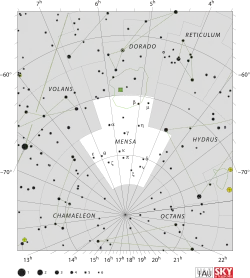 | |
| Observation data Epoch J2000 Equinox J2000 | |
|---|---|
| Constellation | Mensa |
| Right ascension | 05h 50m 16.7857s[1] |
| Declination | −79° 21′ 40.900″[1] |
| Apparent magnitude (V) | 5.45 ± 0.01[2] |
| Characteristics | |
| Evolutionary stage | main sequence[3] |
| Spectral type | B9 V[4] |
| U−B color index | −0.24[5] |
| B−V color index | −0.08[5] |
| Astrometry | |
| Radial velocity (Rv) | 9.5 ± 2[6] km/s |
| Proper motion (μ) | RA: −4.815 mas/yr[1] Dec.: +66.518 mas/yr[1] |
| Parallax (π) | 11.018 ± 0.0604 mas[1] |
| Distance | 296 ± 2 ly (90.8 ± 0.5 pc) |
| Absolute magnitude (MV) | +0.78[7] |
| Details | |
| Mass | 3.44[8] M☉ |
| Radius | 1.95±0.09[9] R☉ |
| Luminosity | 66.4+2.6 −2.5[3] L☉ |
| Surface gravity (log g) | 4.21[8] cgs |
| Temperature | 10,965±50[3] K |
| Metallicity [Fe/H] | 0.00[10] dex |
| Rotational velocity (v sin i) | 290[11] km/s |
| Age | 115[8] Myr |
| Other designations | |
| Database references | |
| SIMBAD | data |
Kappa Mensae, Latinized from κ Mensae, is a solitary[14] star in the southern circumpolar constellation Mensa. Its distance of 296 light years[1] based on its parallax shift gives it an apparent magnitude of 5.45,[2] making it faintly visible to the naked eye. However, it is receding from the Sun with a heliocentric radial velocity of 9.5 km/s.[6]
Kappa Mensae has a stellar classification of B9 V,[4] indicating that it is an ordinary B-type main-sequence star. At present it has 3.44 times the mass of the Sun[8] and a diameter of 1.95 R☉.[9] It radiates at 66[3] times the luminosity from its photosphere at an effective temperature of 10,965 K,[3] giving it a bluish white hue. The star is very young, aged 115 million years,[8] having completed only 33.7% of its main sequence lifetime.[3] Kappa Mensae has a high rate of spin, rotating with a projected rotational velocity of 290 km/s.[11]
References
- 1 2 3 4 5 6 Brown, A. G. A.; et al. (Gaia collaboration) (2021). "Gaia Early Data Release 3: Summary of the contents and survey properties". Astronomy & Astrophysics. 649: A1. arXiv:2012.01533. Bibcode:2021A&A...649A...1G. doi:10.1051/0004-6361/202039657. S2CID 227254300. (Erratum: doi:10.1051/0004-6361/202039657e). Gaia EDR3 record for this source at VizieR.
- 1 2 Høg, E.; Fabricius, C.; Makarov, V. V.; Urban, S.; Corbin, T.; Wycoff, G.; Bastian, U.; Schwekendiek, P.; Wicenec, A. (March 2000). "The Tycho-2 catalogue of the 2.5 million brightest stars". Astronomy and Astrophysics. 355: L27–L30. Bibcode:2000A&A...355L..27H. ISSN 0004-6361.
- 1 2 3 4 5 6 Zorec, J.; Royer, F. (January 2012). "Rotational velocities of A-type stars. IV. Evolution of rotational velocities". Astronomy and Astrophysics. 537: A120. arXiv:1201.2052. Bibcode:2012A&A...537A.120Z. doi:10.1051/0004-6361/201117691. ISSN 0004-6361. S2CID 55586789.
- 1 2 Houk, N.; Cowley, A. P. (1975). University of Michigan Catalogue of two-dimensional spectral types for the HD stars. Volume I. Declinations -90_ to -53_ƒ0. Bibcode:1975mcts.book.....H.
- 1 2 Johnson, H. L.; Mitchell, R. I.; Iriarte, B.; Wisniewski, W. Z. (January 1966). "UBVRIJKL Photometry of the Bright Stars". Communications of the Lunar and Planetary Laboratory. 4: 99–110. Bibcode:1966CoLPL...4...99J.
- 1 2 Evans, D. S. (1967). "The Revision of the General Catalogue of Radial Velocities". International Astronomical Union. 30: 57. Bibcode:1967IAUS...30...57E.
- ↑ Anderson, E.; Francis, Ch. (May 2012). "XHIP: An extended hipparcos compilation". Astronomy Letters. 38 (5): 331–346. arXiv:1108.4971. Bibcode:2012AstL...38..331A. doi:10.1134/S1063773712050015. ISSN 1063-7737. S2CID 119257644.
- 1 2 3 4 5 David, Trevor J.; Hillenbrand, Lynne A. (12 May 2015). "The Ages of Early-Type Stars: StrÖmgren Photometric Methods Calibrated, Validated, Tested, and Applied to Hosts and Prospective Hosts of Directly Imaged Exoplanets". The Astrophysical Journal. 804 (2): 146. arXiv:1501.03154. Bibcode:2015ApJ...804..146D. doi:10.1088/0004-637X/804/2/146. ISSN 1538-4357.
- 1 2 Allende Prieto, C.; Lambert, D. L. (December 1999). "Fundamental parameters of nearby stars from the comparison with evolutionary calculations: masses, radii and effective temperatures". Astronomy and Astrophysics. 352: 555–562. arXiv:astro-ph/9911002. Bibcode:1999A&A...352..555A. ISSN 0004-6361.
- ↑ Gontcharov, G. A. (December 2012). "Dependence of kinematics on the age of stars in the solar neighborhood". Astronomy Letters. 38 (12): 771–782. arXiv:1606.08814. Bibcode:2012AstL...38..771G. doi:10.1134/S1063773712120031. ISSN 0320-0108. S2CID 255201789.
- 1 2 Levato, H.; Grosso, M. (June 2004). "New Projected Rotational Velocities of All Southern B-type Stars of the Bright Star Catalogue". Astronomical Society of the Pacific. 215: 51. Bibcode:2004IAUS..215...51L.
- ↑ "kap Men". SIMBAD. Centre de données astronomiques de Strasbourg. Retrieved June 15, 2022.
- ↑ Gould, Benjamin Apthorp (1878). "Uranometria Argentina : brillantez y posicion de las estrellas fijas, hasta la septima magnitud, comprendidas dentro de cien grados del polo austral : con atlas". Resultados del Observatorio Nacional Argentino. 1. Bibcode:1879RNAO....1.....G.
- ↑ Eggleton, P. P.; Tokovinin, A. A. (11 September 2008). "A catalogue of multiplicity among bright stellar systems". Monthly Notices of the Royal Astronomical Society. 389 (2): 869–879. arXiv:0806.2878. Bibcode:2008MNRAS.389..869E. doi:10.1111/j.1365-2966.2008.13596.x. eISSN 1365-2966. ISSN 0035-8711.